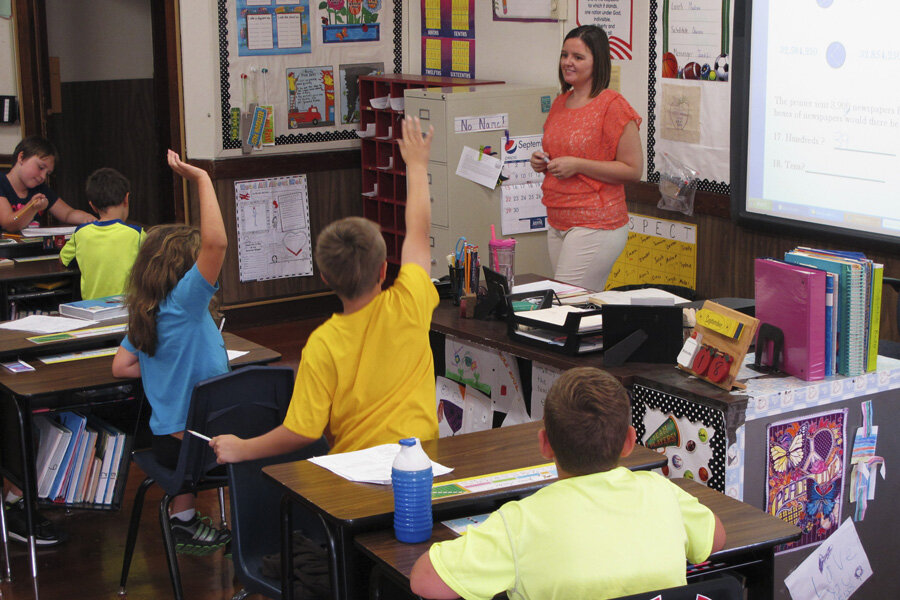US 'report card' for 2013: Student achievement creeps upward
Loading...
America’s students continue to make incremental improvements in math in fourth and eighth grades, and in eighth-grade reading. But schools and educators have made little progress on closing gaps in student performance by race – even over a two-decade period – and the gains that have been made are small ones.
That’s the verdict from the latest data from the National Assessment of Educational Progress (NAEP), otherwise known as the “nation’s report card,” which regularly measures students’ performance on a variety of subjects.
This year’s NAEP results had good news for Hispanic students, who made gains in achievement since 2011 in all areas except fourth-grade reading. And the percentage of students of all races and ethnicities who performed at “proficient” or “advanced” levels grew for fourth-grade math and fourth- and eighth-grade reading.
But even in math, where US students have shown the steadiest and steepest growth in achievement since NAEP was first administered in 1990, the gains were small ones. For fourth-graders, the average math score was 242 on a 500-point scale – 29 points higher than in 1990, and just 1 point higher than in 2011. For eighth-graders, the average score also rose 1 point from 2011, to 285.
“The 2013 NAEP report card provides encouraging but modest signs of progress in both reading and math for US students,” said US Education Secretary Arne Duncan in a press call with reporters late Tuesday. He noted the gains made by Hispanic students, in particular, as well as the “heartening” progress on eighth-grade reading scores, which had been fairly flat for the past decade, but he noted that he’s still not seeing “transformational change” as a nation.
“Even with the modest increases in math and reading performance on the 2013 NAEP, US students are still well behind their peers in top-performing countries,” said Secretary Duncan. “If American students are to continue to thrive and remain competitive in a knowledge-based economy, our schools must continue to accelerate the progress of the past four years, and we all must work harder to narrow America’s large achievement gaps.”
The achievement gaps between white and black students and between white and Hispanic students hasn’t narrowed at all since 2011. In 2013 the gap between the average scores of white and black students is 26 points for both fourth-grade math and fourth-grade reading – although in both cases, there has been a modest narrowing since the early 1990s.
The most notable gains on the 2013 NAEP scores were, perhaps, at the state level, where a few states – notably Tennessee, Hawaii, and the District of Columbia – made some strong gains.
Tennessee and D.C. students made gains between 2011 and 2013 in both subjects and both grades. Fourth-graders in both Tennessee and D.C. scored 7 points better in 2013 on math than they did two years earlier, and eighth-graders in both scored 6 points better. Hawaii's students made significant gains in all areas but fourth-grade reading.
All three were recipients of funds in the federal government’s Race to the Top competition, and Tennessee was one of just two winners in the first round, in 2010.
“If you look at D.C., Tennessee, Hawaii – they’ve done some really tough work, and it’s showing some pretty remarkable dividends,” said Duncan, noting that some people “scoffed” when Hawaii was selected as a winner. “Hawaii to their tremendous credit have proved a lot of skeptics wrong,” he said.
NAEP identifies three achievement levels – basic, proficient, and advanced – and 2013 showed some improvement in the share of students scoring in the proficient and advanced levels in both subjects at both grades.
In fourth-grade math, for instance, 42 percent of students performed at or above “proficient” in 2013, compared with 40 percent in 2011.
Such students were able to do things such as determine the perimeter of a rectangle and compare unit fractions in context. (This year’s NAEP results are debuting with a brand-new website that allows viewers to find and sort data, view sample questions, and compare results.)
“Today’s results give me hope, as more students are performing at or above the ‘proficient’ level – which tells me that they are demonstrating competency over challenging subject matter when it comes to math and reading,” said David Driscoll, chairman of the National Assessment Governing Board, in a statement.
But other education experts say this year’s NAEP results mostly indicate how slow the progress is among American students, especially compared with their counterparts in other countries.
“They basically show that we were making gains that were twice as fast in the first decade of the 21st century,” says Paul Peterson, director of the Program on Education Policy and Governance at Harvard University and a senior fellow at the Hoover Institution at Stanford University. “The story is a slowdown in the gains from where we once were.”
Mr. Peterson notes that he’s particularly disappointed in the lack of progress on addressing the achievement gap, which, in some cases, had been closing. “If we’ve abandoned accountability, which I think we have, has that led to the system going back to its old stagnant ways?” he asks.
In the past, says Peterson, US students were making gains at about the same rate as the average of many peer countries around the world, but that's no longer happening.
“If other countries can make those gains, why can’t we?” he says. “If the rest of the world continues to move forward, and we’re only creeping along, then we need to do better, and we’re not doing even as well as we were.”






